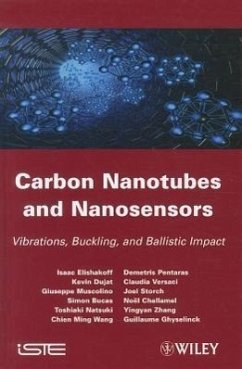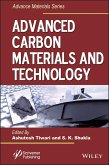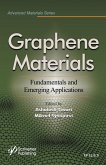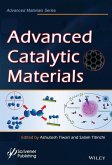Isaac Elishakoff, Noël Challamel, Yingyan Zhang, Guillaume Ghyselinck, Kevin Dujat, Giuseppe Muscolino, Simon Bucas, Toshiaki Natsuki, Chien Ming Wang, Demetris Pentaras, Claudia Versaci, Joel Storch
Carbon Nanotubes and Nanosensors
Vibration, Buckling and Balistic Impact
Isaac Elishakoff, Noël Challamel, Yingyan Zhang, Guillaume Ghyselinck, Kevin Dujat, Giuseppe Muscolino, Simon Bucas, Toshiaki Natsuki, Chien Ming Wang, Demetris Pentaras, Claudia Versaci, Joel Storch
Carbon Nanotubes and Nanosensors
Vibration, Buckling and Balistic Impact
- Gebundenes Buch
- Merkliste
- Auf die Merkliste
- Bewerten Bewerten
- Teilen
- Produkt teilen
- Produkterinnerung
- Produkterinnerung
The main properties that make carbon nanotubes (CNTs) a promising technology for many future applications are: extremely high strength, low mass density, linear elastic behavior, almost perfect geometrical structure, and nanometer scale structure. Also, CNTs can conduct electricity better than copper and transmit heat better than diamonds. Therefore, they are bound to find a wide, and possibly revolutionary use in all fields of engineering. The interest in CNTs and their potential use in a wide range of commercial applications; such as nanoelectronics, quantum wire interconnects, field…mehr
Andere Kunden interessierten sich auch für
![Advanced Carbon Materials and Technology Advanced Carbon Materials and Technology]() Advanced Carbon Materials and Technology207,99 €
Advanced Carbon Materials and Technology207,99 €![Graphene Materials Graphene Materials]() Ashutosh TiwariGraphene Materials206,99 €
Ashutosh TiwariGraphene Materials206,99 €![Advanced Catalytic Materials Advanced Catalytic Materials]() Advanced Catalytic Materials199,99 €
Advanced Catalytic Materials199,99 €![Carbon Nanotubes and Their Applications Carbon Nanotubes and Their Applications]() Carbon Nanotubes and Their Applications165,99 €
Carbon Nanotubes and Their Applications165,99 €![Carbon Nanotubes Carbon Nanotubes]() A K HaghiCarbon Nanotubes175,99 €
A K HaghiCarbon Nanotubes175,99 €![Carbon Nanotubes - Recent Advances, New Perspectives and Potential Applications Carbon Nanotubes - Recent Advances, New Perspectives and Potential Applications]() Carbon Nanotubes - Recent Advances, New Perspectives and Potential Applications118,99 €
Carbon Nanotubes - Recent Advances, New Perspectives and Potential Applications118,99 €![Designing Nanosensors for Chemical and Biological Applications Designing Nanosensors for Chemical and Biological Applications]() Sergey YurishDesigning Nanosensors for Chemical and Biological Applications88,99 €
Sergey YurishDesigning Nanosensors for Chemical and Biological Applications88,99 €-
-
-
The main properties that make carbon nanotubes (CNTs) a promising technology for many future applications are: extremely high strength, low mass density, linear elastic behavior, almost perfect geometrical structure, and nanometer scale structure. Also, CNTs can conduct electricity better than copper and transmit heat better than diamonds. Therefore, they are bound to find a wide, and possibly revolutionary use in all fields of engineering. The interest in CNTs and their potential use in a wide range of commercial applications; such as nanoelectronics, quantum wire interconnects, field emission devices, composites, chemical sensors, biosensors, detectors, etc.; have rapidly increased in the last two decades. However, the performance of any CNT-based nanostructure is dependent on the mechanical properties of constituent CNTs. Therefore, it is crucial to know the mechanical behavior of individual CNTs such as their vibration frequencies, buckling loads, and deformations under different loadings. This title is dedicated to the vibration, buckling and impact behavior of CNTs, along with theory for carbon nanosensors, like the Bubnov-Galerkin and the Petrov-Galerkin methods, the Bresse-Timoshenko and the Donnell shell theory.
Produktdetails
- Produktdetails
- Verlag: Wiley
- Seitenzahl: 448
- Erscheinungstermin: 13. Februar 2012
- Englisch
- Abmessung: 234mm x 157mm x 30mm
- Gewicht: 771g
- ISBN-13: 9781848213456
- ISBN-10: 184821345X
- Artikelnr.: 34790145
- Herstellerkennzeichnung
- Libri GmbH
- Europaallee 1
- 36244 Bad Hersfeld
- gpsr@libri.de
- Verlag: Wiley
- Seitenzahl: 448
- Erscheinungstermin: 13. Februar 2012
- Englisch
- Abmessung: 234mm x 157mm x 30mm
- Gewicht: 771g
- ISBN-13: 9781848213456
- ISBN-10: 184821345X
- Artikelnr.: 34790145
- Herstellerkennzeichnung
- Libri GmbH
- Europaallee 1
- 36244 Bad Hersfeld
- gpsr@libri.de
Prof. Isaac Elishakoff, Florida Atlantic University, USA. Dr. Demetris Pentaras, Cyprus University of Technology, Cyprus. Ing. Kevin Dujat and Ing. Simon Bucas, IFMA - French Institute for Advanced Mechanics, France. Dr. Claudia Versaci and Prof. Giuseppe Muscolino, University of Messina, Italy. Dr. Joel Storch, Touro College, USA. Prof. Noël Challamel, University of South Brittany, France. Prof. Toshiaki Natsuki, Shinsu University, Japan. Dr. Yingyan Zhang, University of Western Sydney, Australia. Prof. Chien Ming Wang, National University of Singapore, Singapore. Ing. Guillaume Ghyselinck, Ecole des Mines d'Alès, France.
Preface xi
Chapter 1. Introduction 1
1.1. The need of determining the natural frequencies and buckling loads of
CNTs 8
1.2. Determination of natural frequencies of SWCNT as a uniform beam model
and MWCNT during coaxial deflection 8
1.3. Beam model of MWCNT 9
1.4. CNTs embedded in an elastic medium 10
Chapter 2. Fundamental Natural Frequencies of Double-Walled
Carbon Nanotubes 13
2.1. Background 13
2.2. Analysis 15
2.3. Simply supported DWCNT: exact solution 15
2.4. Simply supported DWCNT: Bubnov-Galerkin method 18
2.5. Simply supported DWCNT: Petrov-Galerkin method 20
2.6. Clamped-clamped DWCNT: Bubnov-Galerkin method 23
2.7. Clamped-clamped DWCNT: Petrov-Galerkin method 25
2.8. Simply supported-clamped DWCNT 27
2.9. Clamped-free DWCNT 30
2.10. Comparison with results of Natsuki et al. [NAT 08a] 33
2.11. On closing the gap on carbon nanotubes 34
2.12. Discussion 45
Chapter 3. Free Vibrations of the Triple-Walled Carbon Nanotubes 47
3.1. Background 47
3.2. Analysis 48
3.3. Simply supported TWCNT: exact solution 49
3.4. Simply supported TWCNT: approximate solutions 51
3.5. Clamped-clamped TWCNT: approximate solutions 54
3.6. Simply supported-clamped TWCNT: approximate solutions 57
3.7. Clamped-free TWCNT: approximate solutions 60
3.8. Summary 63
Chapter 4. Exact Solution for Natural Frequencies of Clamped-Clamped
Double-Walled Carbon Nanotubes 65
4.1. Background 65
4.2. Analysis 67
4.3. Analytical exact solution 72
4.4. Numerical results and discussion 77
4.5. Discussion 82
4.6. Summary 83
Chapter 5. Natural Frequencies of Carbon Nanotubes Based on a Consistent
Version of Bresse-Timoshenko Theory 85
5.1. Background 85
5.2. Bresse-Timoshenko equations for homogeneous beams 86
5.3. DWCNT modeled on the basis of consistent Bresse-Timoshenko equations
88
5.4. Numerical results and discussion 91
Chapter 6. Natural Frequencies of Double-Walled Carbon Nanotubes Based on
Donnell Shell Theory 97
6.1. Background 97
6.2. Donnell shell theory for the vibration of MWCNTs 99
6.3. Donnell shell theory for the vibration of a simply supported DWCNT 100
6.4. DWCNT modeled on the basis of simplified Donnell shell theory 103
6.5. Further simplifications of the Donnell shell theory 105
6.6. Summary 107
Chapter 7. Buckling of a Double-Walled Carbon Nanotube 109
7.1. Background 109
7.2. Analysis 111
7.3. Simply supported DWCNT: exact solution 112
7.4. Simply supported DWCNT: Bubnov-Galerkin method 114
7.5. Simply supported DWCNTs: Petrov-Galerkin method 116
7.6. Clamped-clamped DWCNT 117
7.7. Simply supported-clamped DWCNT 119
7.8. Buckling of a clamped-free DWCNT by finite difference method 121
7.9. Buckling of a clamped-free DWCNT by Bubnov-Galerkin method 131
7.10. Summary 137
Chapter 8. Ballistic Impact on a Single-Walled Carbon Nanotube 139
8.1. Background 139
8.2. Analysis 140
8.3. Numerical results and discussion 144
Chapter 9. Clamped-Free Double-Walled Carbon Nanotube-Based Mass Sensor 149
9.1. Introduction 149
9.2. Basic equations 150
9.3. Vibration frequencies of DWCNT with light bacterium at the end of
outer nanotube 152
9.4. Vibration frequencies of DWCNT with heavy bacterium at the end of
outer nanotube 159
9.5. Vibration frequencies of DWCNT with light bacterium at the end of
inner nanotube 165
9.6. Vibration frequencies of DWCNT with heavy bacterium at the end of
inner nanotube 170
9.7. Numerical results 176
9.8. Effective stiffness and effective mass of the double-walled carbon
nanotube sensor 178
9.9. Virus sensor based on single-walled carbon nanotube treated as
Bresse-Timoshenko beam 190
9.10. Conclusion 201
Chapter 10. Some Fundamental Aspects of Non-local Beam Mechanics for
Nanostructures Applications 203
10.1. Background on the need of non-locality 204
10.2. Non-local beam models 209
10.3. The cantilever case: a structural paradigm 218
10.4. Euler-Bernoulli beam: Eringen's based model 231
10.5. Euler-Bernoulli beam: gradient elasticity model 234
10.6. Euler-Bernoulli beam: hybrid non-local elasticity model 236
10.7. Timoshenko beam: Eringen's based model 238
10.8. Timoshenko beam: gradient elasticity model 244
10.9. Timoshenko beam, hybrid non-local elasticity model 251
10.10. Higher order shear beam: Eringen's based model 254
10.11. Higher order shear beam, gradient elasticity model 259
10.12. Validity of the results for double-nanobeam systems 262
Chapter 11. Surface Effects on the Natural Frequencies of Double-Walled
Carbon Nanotubes 269
11.1. Background 269
11.2. Analysis 271
11.3. Results and discussion 279
11.4. Surface effects on buckling of nanotubes 286
11.5. Summary 289
Chapter 12. Summary and Directions for Future Research 291
Appendix A. Elements of the Matrix A 297
Appendix B. Elements of the Matrix B 299
Appendix C. Coefficients of the Polynomial Equation [7.116] 301
Appendix D. Coefficients of the Polynomial Equation [9.25] 303
Appendix E. Coefficients of the Polynomial Equation [9.35] 305
Appendix F. Coefficients of the Polynomial Equation [9.40] 307
Appendix G. Coefficients of the Polynomial Equation [9.54] 311
Appendix H. Coefficients of the Polynomial Equation [9.63] 313
Appendix I. Coefficients of the Polynomial Equation [9.67] 315
Appendix J. An Equation Both More Consistent and Simpler than the
Bresse-Timoshenko Equation 319
Bibliography 325
Author Index 399
Subject Index 415
Chapter 1. Introduction 1
1.1. The need of determining the natural frequencies and buckling loads of
CNTs 8
1.2. Determination of natural frequencies of SWCNT as a uniform beam model
and MWCNT during coaxial deflection 8
1.3. Beam model of MWCNT 9
1.4. CNTs embedded in an elastic medium 10
Chapter 2. Fundamental Natural Frequencies of Double-Walled
Carbon Nanotubes 13
2.1. Background 13
2.2. Analysis 15
2.3. Simply supported DWCNT: exact solution 15
2.4. Simply supported DWCNT: Bubnov-Galerkin method 18
2.5. Simply supported DWCNT: Petrov-Galerkin method 20
2.6. Clamped-clamped DWCNT: Bubnov-Galerkin method 23
2.7. Clamped-clamped DWCNT: Petrov-Galerkin method 25
2.8. Simply supported-clamped DWCNT 27
2.9. Clamped-free DWCNT 30
2.10. Comparison with results of Natsuki et al. [NAT 08a] 33
2.11. On closing the gap on carbon nanotubes 34
2.12. Discussion 45
Chapter 3. Free Vibrations of the Triple-Walled Carbon Nanotubes 47
3.1. Background 47
3.2. Analysis 48
3.3. Simply supported TWCNT: exact solution 49
3.4. Simply supported TWCNT: approximate solutions 51
3.5. Clamped-clamped TWCNT: approximate solutions 54
3.6. Simply supported-clamped TWCNT: approximate solutions 57
3.7. Clamped-free TWCNT: approximate solutions 60
3.8. Summary 63
Chapter 4. Exact Solution for Natural Frequencies of Clamped-Clamped
Double-Walled Carbon Nanotubes 65
4.1. Background 65
4.2. Analysis 67
4.3. Analytical exact solution 72
4.4. Numerical results and discussion 77
4.5. Discussion 82
4.6. Summary 83
Chapter 5. Natural Frequencies of Carbon Nanotubes Based on a Consistent
Version of Bresse-Timoshenko Theory 85
5.1. Background 85
5.2. Bresse-Timoshenko equations for homogeneous beams 86
5.3. DWCNT modeled on the basis of consistent Bresse-Timoshenko equations
88
5.4. Numerical results and discussion 91
Chapter 6. Natural Frequencies of Double-Walled Carbon Nanotubes Based on
Donnell Shell Theory 97
6.1. Background 97
6.2. Donnell shell theory for the vibration of MWCNTs 99
6.3. Donnell shell theory for the vibration of a simply supported DWCNT 100
6.4. DWCNT modeled on the basis of simplified Donnell shell theory 103
6.5. Further simplifications of the Donnell shell theory 105
6.6. Summary 107
Chapter 7. Buckling of a Double-Walled Carbon Nanotube 109
7.1. Background 109
7.2. Analysis 111
7.3. Simply supported DWCNT: exact solution 112
7.4. Simply supported DWCNT: Bubnov-Galerkin method 114
7.5. Simply supported DWCNTs: Petrov-Galerkin method 116
7.6. Clamped-clamped DWCNT 117
7.7. Simply supported-clamped DWCNT 119
7.8. Buckling of a clamped-free DWCNT by finite difference method 121
7.9. Buckling of a clamped-free DWCNT by Bubnov-Galerkin method 131
7.10. Summary 137
Chapter 8. Ballistic Impact on a Single-Walled Carbon Nanotube 139
8.1. Background 139
8.2. Analysis 140
8.3. Numerical results and discussion 144
Chapter 9. Clamped-Free Double-Walled Carbon Nanotube-Based Mass Sensor 149
9.1. Introduction 149
9.2. Basic equations 150
9.3. Vibration frequencies of DWCNT with light bacterium at the end of
outer nanotube 152
9.4. Vibration frequencies of DWCNT with heavy bacterium at the end of
outer nanotube 159
9.5. Vibration frequencies of DWCNT with light bacterium at the end of
inner nanotube 165
9.6. Vibration frequencies of DWCNT with heavy bacterium at the end of
inner nanotube 170
9.7. Numerical results 176
9.8. Effective stiffness and effective mass of the double-walled carbon
nanotube sensor 178
9.9. Virus sensor based on single-walled carbon nanotube treated as
Bresse-Timoshenko beam 190
9.10. Conclusion 201
Chapter 10. Some Fundamental Aspects of Non-local Beam Mechanics for
Nanostructures Applications 203
10.1. Background on the need of non-locality 204
10.2. Non-local beam models 209
10.3. The cantilever case: a structural paradigm 218
10.4. Euler-Bernoulli beam: Eringen's based model 231
10.5. Euler-Bernoulli beam: gradient elasticity model 234
10.6. Euler-Bernoulli beam: hybrid non-local elasticity model 236
10.7. Timoshenko beam: Eringen's based model 238
10.8. Timoshenko beam: gradient elasticity model 244
10.9. Timoshenko beam, hybrid non-local elasticity model 251
10.10. Higher order shear beam: Eringen's based model 254
10.11. Higher order shear beam, gradient elasticity model 259
10.12. Validity of the results for double-nanobeam systems 262
Chapter 11. Surface Effects on the Natural Frequencies of Double-Walled
Carbon Nanotubes 269
11.1. Background 269
11.2. Analysis 271
11.3. Results and discussion 279
11.4. Surface effects on buckling of nanotubes 286
11.5. Summary 289
Chapter 12. Summary and Directions for Future Research 291
Appendix A. Elements of the Matrix A 297
Appendix B. Elements of the Matrix B 299
Appendix C. Coefficients of the Polynomial Equation [7.116] 301
Appendix D. Coefficients of the Polynomial Equation [9.25] 303
Appendix E. Coefficients of the Polynomial Equation [9.35] 305
Appendix F. Coefficients of the Polynomial Equation [9.40] 307
Appendix G. Coefficients of the Polynomial Equation [9.54] 311
Appendix H. Coefficients of the Polynomial Equation [9.63] 313
Appendix I. Coefficients of the Polynomial Equation [9.67] 315
Appendix J. An Equation Both More Consistent and Simpler than the
Bresse-Timoshenko Equation 319
Bibliography 325
Author Index 399
Subject Index 415
Preface xi
Chapter 1. Introduction 1
1.1. The need of determining the natural frequencies and buckling loads of
CNTs 8
1.2. Determination of natural frequencies of SWCNT as a uniform beam model
and MWCNT during coaxial deflection 8
1.3. Beam model of MWCNT 9
1.4. CNTs embedded in an elastic medium 10
Chapter 2. Fundamental Natural Frequencies of Double-Walled
Carbon Nanotubes 13
2.1. Background 13
2.2. Analysis 15
2.3. Simply supported DWCNT: exact solution 15
2.4. Simply supported DWCNT: Bubnov-Galerkin method 18
2.5. Simply supported DWCNT: Petrov-Galerkin method 20
2.6. Clamped-clamped DWCNT: Bubnov-Galerkin method 23
2.7. Clamped-clamped DWCNT: Petrov-Galerkin method 25
2.8. Simply supported-clamped DWCNT 27
2.9. Clamped-free DWCNT 30
2.10. Comparison with results of Natsuki et al. [NAT 08a] 33
2.11. On closing the gap on carbon nanotubes 34
2.12. Discussion 45
Chapter 3. Free Vibrations of the Triple-Walled Carbon Nanotubes 47
3.1. Background 47
3.2. Analysis 48
3.3. Simply supported TWCNT: exact solution 49
3.4. Simply supported TWCNT: approximate solutions 51
3.5. Clamped-clamped TWCNT: approximate solutions 54
3.6. Simply supported-clamped TWCNT: approximate solutions 57
3.7. Clamped-free TWCNT: approximate solutions 60
3.8. Summary 63
Chapter 4. Exact Solution for Natural Frequencies of Clamped-Clamped
Double-Walled Carbon Nanotubes 65
4.1. Background 65
4.2. Analysis 67
4.3. Analytical exact solution 72
4.4. Numerical results and discussion 77
4.5. Discussion 82
4.6. Summary 83
Chapter 5. Natural Frequencies of Carbon Nanotubes Based on a Consistent
Version of Bresse-Timoshenko Theory 85
5.1. Background 85
5.2. Bresse-Timoshenko equations for homogeneous beams 86
5.3. DWCNT modeled on the basis of consistent Bresse-Timoshenko equations
88
5.4. Numerical results and discussion 91
Chapter 6. Natural Frequencies of Double-Walled Carbon Nanotubes Based on
Donnell Shell Theory 97
6.1. Background 97
6.2. Donnell shell theory for the vibration of MWCNTs 99
6.3. Donnell shell theory for the vibration of a simply supported DWCNT 100
6.4. DWCNT modeled on the basis of simplified Donnell shell theory 103
6.5. Further simplifications of the Donnell shell theory 105
6.6. Summary 107
Chapter 7. Buckling of a Double-Walled Carbon Nanotube 109
7.1. Background 109
7.2. Analysis 111
7.3. Simply supported DWCNT: exact solution 112
7.4. Simply supported DWCNT: Bubnov-Galerkin method 114
7.5. Simply supported DWCNTs: Petrov-Galerkin method 116
7.6. Clamped-clamped DWCNT 117
7.7. Simply supported-clamped DWCNT 119
7.8. Buckling of a clamped-free DWCNT by finite difference method 121
7.9. Buckling of a clamped-free DWCNT by Bubnov-Galerkin method 131
7.10. Summary 137
Chapter 8. Ballistic Impact on a Single-Walled Carbon Nanotube 139
8.1. Background 139
8.2. Analysis 140
8.3. Numerical results and discussion 144
Chapter 9. Clamped-Free Double-Walled Carbon Nanotube-Based Mass Sensor 149
9.1. Introduction 149
9.2. Basic equations 150
9.3. Vibration frequencies of DWCNT with light bacterium at the end of
outer nanotube 152
9.4. Vibration frequencies of DWCNT with heavy bacterium at the end of
outer nanotube 159
9.5. Vibration frequencies of DWCNT with light bacterium at the end of
inner nanotube 165
9.6. Vibration frequencies of DWCNT with heavy bacterium at the end of
inner nanotube 170
9.7. Numerical results 176
9.8. Effective stiffness and effective mass of the double-walled carbon
nanotube sensor 178
9.9. Virus sensor based on single-walled carbon nanotube treated as
Bresse-Timoshenko beam 190
9.10. Conclusion 201
Chapter 10. Some Fundamental Aspects of Non-local Beam Mechanics for
Nanostructures Applications 203
10.1. Background on the need of non-locality 204
10.2. Non-local beam models 209
10.3. The cantilever case: a structural paradigm 218
10.4. Euler-Bernoulli beam: Eringen's based model 231
10.5. Euler-Bernoulli beam: gradient elasticity model 234
10.6. Euler-Bernoulli beam: hybrid non-local elasticity model 236
10.7. Timoshenko beam: Eringen's based model 238
10.8. Timoshenko beam: gradient elasticity model 244
10.9. Timoshenko beam, hybrid non-local elasticity model 251
10.10. Higher order shear beam: Eringen's based model 254
10.11. Higher order shear beam, gradient elasticity model 259
10.12. Validity of the results for double-nanobeam systems 262
Chapter 11. Surface Effects on the Natural Frequencies of Double-Walled
Carbon Nanotubes 269
11.1. Background 269
11.2. Analysis 271
11.3. Results and discussion 279
11.4. Surface effects on buckling of nanotubes 286
11.5. Summary 289
Chapter 12. Summary and Directions for Future Research 291
Appendix A. Elements of the Matrix A 297
Appendix B. Elements of the Matrix B 299
Appendix C. Coefficients of the Polynomial Equation [7.116] 301
Appendix D. Coefficients of the Polynomial Equation [9.25] 303
Appendix E. Coefficients of the Polynomial Equation [9.35] 305
Appendix F. Coefficients of the Polynomial Equation [9.40] 307
Appendix G. Coefficients of the Polynomial Equation [9.54] 311
Appendix H. Coefficients of the Polynomial Equation [9.63] 313
Appendix I. Coefficients of the Polynomial Equation [9.67] 315
Appendix J. An Equation Both More Consistent and Simpler than the
Bresse-Timoshenko Equation 319
Bibliography 325
Author Index 399
Subject Index 415
Chapter 1. Introduction 1
1.1. The need of determining the natural frequencies and buckling loads of
CNTs 8
1.2. Determination of natural frequencies of SWCNT as a uniform beam model
and MWCNT during coaxial deflection 8
1.3. Beam model of MWCNT 9
1.4. CNTs embedded in an elastic medium 10
Chapter 2. Fundamental Natural Frequencies of Double-Walled
Carbon Nanotubes 13
2.1. Background 13
2.2. Analysis 15
2.3. Simply supported DWCNT: exact solution 15
2.4. Simply supported DWCNT: Bubnov-Galerkin method 18
2.5. Simply supported DWCNT: Petrov-Galerkin method 20
2.6. Clamped-clamped DWCNT: Bubnov-Galerkin method 23
2.7. Clamped-clamped DWCNT: Petrov-Galerkin method 25
2.8. Simply supported-clamped DWCNT 27
2.9. Clamped-free DWCNT 30
2.10. Comparison with results of Natsuki et al. [NAT 08a] 33
2.11. On closing the gap on carbon nanotubes 34
2.12. Discussion 45
Chapter 3. Free Vibrations of the Triple-Walled Carbon Nanotubes 47
3.1. Background 47
3.2. Analysis 48
3.3. Simply supported TWCNT: exact solution 49
3.4. Simply supported TWCNT: approximate solutions 51
3.5. Clamped-clamped TWCNT: approximate solutions 54
3.6. Simply supported-clamped TWCNT: approximate solutions 57
3.7. Clamped-free TWCNT: approximate solutions 60
3.8. Summary 63
Chapter 4. Exact Solution for Natural Frequencies of Clamped-Clamped
Double-Walled Carbon Nanotubes 65
4.1. Background 65
4.2. Analysis 67
4.3. Analytical exact solution 72
4.4. Numerical results and discussion 77
4.5. Discussion 82
4.6. Summary 83
Chapter 5. Natural Frequencies of Carbon Nanotubes Based on a Consistent
Version of Bresse-Timoshenko Theory 85
5.1. Background 85
5.2. Bresse-Timoshenko equations for homogeneous beams 86
5.3. DWCNT modeled on the basis of consistent Bresse-Timoshenko equations
88
5.4. Numerical results and discussion 91
Chapter 6. Natural Frequencies of Double-Walled Carbon Nanotubes Based on
Donnell Shell Theory 97
6.1. Background 97
6.2. Donnell shell theory for the vibration of MWCNTs 99
6.3. Donnell shell theory for the vibration of a simply supported DWCNT 100
6.4. DWCNT modeled on the basis of simplified Donnell shell theory 103
6.5. Further simplifications of the Donnell shell theory 105
6.6. Summary 107
Chapter 7. Buckling of a Double-Walled Carbon Nanotube 109
7.1. Background 109
7.2. Analysis 111
7.3. Simply supported DWCNT: exact solution 112
7.4. Simply supported DWCNT: Bubnov-Galerkin method 114
7.5. Simply supported DWCNTs: Petrov-Galerkin method 116
7.6. Clamped-clamped DWCNT 117
7.7. Simply supported-clamped DWCNT 119
7.8. Buckling of a clamped-free DWCNT by finite difference method 121
7.9. Buckling of a clamped-free DWCNT by Bubnov-Galerkin method 131
7.10. Summary 137
Chapter 8. Ballistic Impact on a Single-Walled Carbon Nanotube 139
8.1. Background 139
8.2. Analysis 140
8.3. Numerical results and discussion 144
Chapter 9. Clamped-Free Double-Walled Carbon Nanotube-Based Mass Sensor 149
9.1. Introduction 149
9.2. Basic equations 150
9.3. Vibration frequencies of DWCNT with light bacterium at the end of
outer nanotube 152
9.4. Vibration frequencies of DWCNT with heavy bacterium at the end of
outer nanotube 159
9.5. Vibration frequencies of DWCNT with light bacterium at the end of
inner nanotube 165
9.6. Vibration frequencies of DWCNT with heavy bacterium at the end of
inner nanotube 170
9.7. Numerical results 176
9.8. Effective stiffness and effective mass of the double-walled carbon
nanotube sensor 178
9.9. Virus sensor based on single-walled carbon nanotube treated as
Bresse-Timoshenko beam 190
9.10. Conclusion 201
Chapter 10. Some Fundamental Aspects of Non-local Beam Mechanics for
Nanostructures Applications 203
10.1. Background on the need of non-locality 204
10.2. Non-local beam models 209
10.3. The cantilever case: a structural paradigm 218
10.4. Euler-Bernoulli beam: Eringen's based model 231
10.5. Euler-Bernoulli beam: gradient elasticity model 234
10.6. Euler-Bernoulli beam: hybrid non-local elasticity model 236
10.7. Timoshenko beam: Eringen's based model 238
10.8. Timoshenko beam: gradient elasticity model 244
10.9. Timoshenko beam, hybrid non-local elasticity model 251
10.10. Higher order shear beam: Eringen's based model 254
10.11. Higher order shear beam, gradient elasticity model 259
10.12. Validity of the results for double-nanobeam systems 262
Chapter 11. Surface Effects on the Natural Frequencies of Double-Walled
Carbon Nanotubes 269
11.1. Background 269
11.2. Analysis 271
11.3. Results and discussion 279
11.4. Surface effects on buckling of nanotubes 286
11.5. Summary 289
Chapter 12. Summary and Directions for Future Research 291
Appendix A. Elements of the Matrix A 297
Appendix B. Elements of the Matrix B 299
Appendix C. Coefficients of the Polynomial Equation [7.116] 301
Appendix D. Coefficients of the Polynomial Equation [9.25] 303
Appendix E. Coefficients of the Polynomial Equation [9.35] 305
Appendix F. Coefficients of the Polynomial Equation [9.40] 307
Appendix G. Coefficients of the Polynomial Equation [9.54] 311
Appendix H. Coefficients of the Polynomial Equation [9.63] 313
Appendix I. Coefficients of the Polynomial Equation [9.67] 315
Appendix J. An Equation Both More Consistent and Simpler than the
Bresse-Timoshenko Equation 319
Bibliography 325
Author Index 399
Subject Index 415

